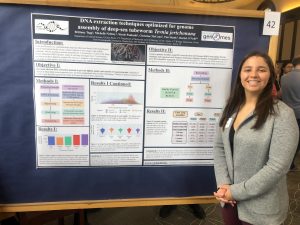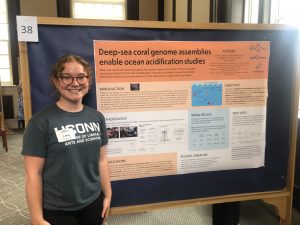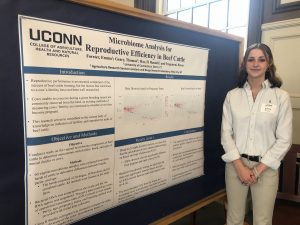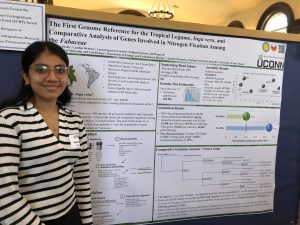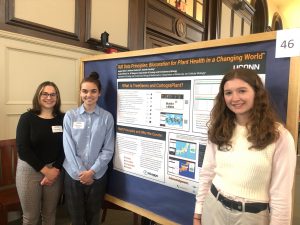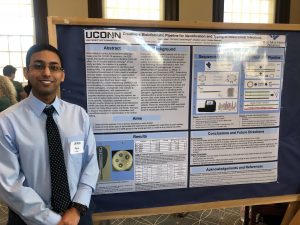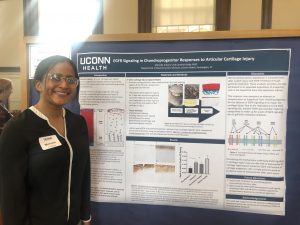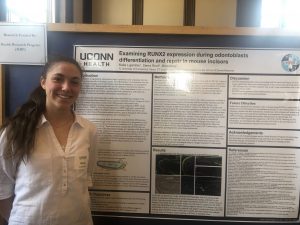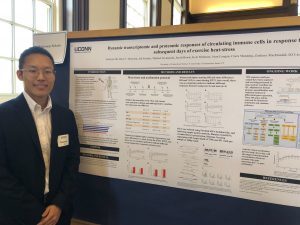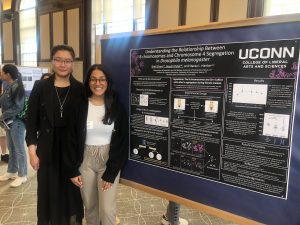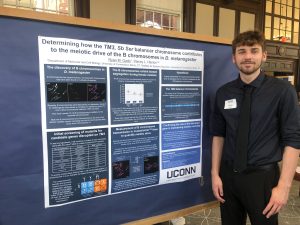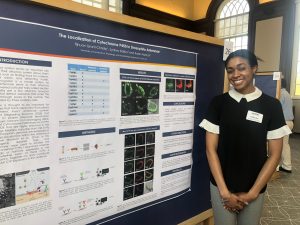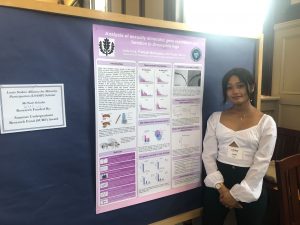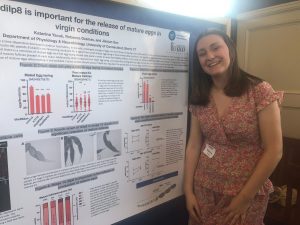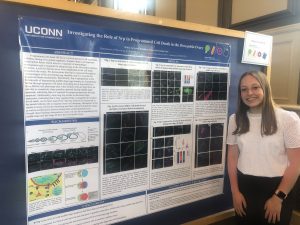Click here for full article on UConn Today.
Author: Jessica Williamson
ISG’s Annual Report 2023-24
Follow this link for the full Annual Report.
Congratulations to the ISG Networking Event Poster Winners, Vuruputoor and Weiner.
Best poster: Vidya Vuruputoor, Department of Ecology & Evolutionary Biology
Title: From needles to reads: Utilizing ‘omics’ technologies to inform conservation of the eastern hemloc
Most creative: Samson Weiner, Department of Computer Science & Engineering
Title: Simulation of metastatic spread under cancer type-specific patterns
UConn RaMP Scholars Publish First-of-its Kind Scorpion Genome
FOLLOW THIS LINK FOR THE FULL ARTICLE FROM UCONN TODAY.
By Jaclyn Severance
A team of researchers at UConn, in collaboration with Carlos Santibanez-Lopez at Western Connecticut State University, have generated the first chromosome-level genome of the desert hairy scorpion – an iconic inhabitant of the Mojave and Sonoran deserts of North America and the largest scorpion found on the continent.
While there are over 100,000 known species of arachnids, genomic research to date has predominately focused on two groups – spiders and ticks – and genomic research into scorpions has primarily involved the large Buthidae family.
The UConn team’s work with Hadrurus arizonensis – a solitary and nocturnal arachnid that can grow up to six inches in length – details the first genome assembled and annotated for a species in the smaller Hadruridae family of scorpions.
Their work is also the first chromosome-level genome assembly of any scorpion from either family – helping to fill a crucial gap in the genomic knowledge of scorpions, shedding light on the evolutionary development and diversification of arachnids, and advancing studies in comparative and functional genomics.
The team published their work in the May 2024 edition of the journal Genome Biology and Evolution.
But perhaps just as remarkable as the publication of this first-of-its-kind genomic research is the research team itself – a diverse group of scholars in an intensive postbaccalaureate program who’ve spent the last year in Storrs getting a crash course in hands-on skills while each working to find their own place in the research world.
‘Diverse Experiences’
While each of the eight scholars in the first cohort of UConn’s National Science Foundation supported Research and Mentoring for Postbaccalaureates program, or RaMP, has their own unique interests, they share similar reasons for why they wanted to join the program after they completed their undergraduate studies – some at UConn and some elsewhere – in the spring of 2023.
Jennifer Santiago Membreño and Aviel Rodriguez each graduated from the University of Puerto Rico, where massive disruptions caused by Hurricane Maria and the COVID-19 pandemic limited their ability to gain valuable research experience as undergrads.
“It was a pretty tumultuous time,” says Santiago Membreño. “Life was continuously being paused.”
Samuel Pring, who attended Bucknell University, found an interest in RNA research, but had fewer opportunities to take classes and expand his research efforts at his small college in Pennsylvania.
Like many undergraduate students, Adam Glendening ’23 (CLAS) and Carolina Jara ’23 (CLAS) both had to work while also going to school, leaving them less time to take on research and independent projects.
“After graduation, it turns out a lot of places don’t take landscaping as fieldwork experience,” Glendening says.
Samuel Hilliman ’23 (CLAS) gained an interest in research while studying at UConn, but didn’t get the hands-on experience needed to develop his own interests.
Meridia Jane Bryant, who graduated from the University of Kansas, found that her life and research interests changed after she transitioned while an undergraduate – she wanted to shift gears and focus more on bioinformatics, but didn’t have the experience to do so.
When Asher Coello ’23 (CLAS) changed to UConn Storrs from a regional campus, he struggled to make inroads into the research community.
“I’ve always just been in the books,” Coello says. “I’ve never actually been in the lab doing stuff.”
Their stories are familiar to Elizabeth Jockusch, a professor in UConn’s Department of Ecology and Evolutionary Biology and the principal investigator and lead mentor for RaMP at UConn.
“We’re at a Research 1 university,” Jockusch says. “There are research opportunities here. And yet, we see how many students can’t take advantage of them, so it’s clear that there’s this huge need.
“The reason that the program appealed to me – the reason that we brought everyone together and wrote the grant – is that, essentially, we see the need in our students.”
In 2022, Jockusch and a team of faculty collaborators received that grant – for just under $3 million – from the National Science Foundation RaMP in Biological Sciences program, which invites proposal submissions to establish networks that support full-time research, mentoring, and training for recent college graduates who have had few or no research or training opportunities during college.
Part of the NSF funding program’s goal is to support a globally competitive and culturally diverse STEM workforce by recruiting and training individuals for a range of potential career pathways in biological sciences.
“This is maybe an exaggeration, but it feels like kind of a last chance to hook people into the STEM pipeline of education,” Jockusch says. “If you graduate and your field experience is landscaping, because that’s how you were paying the bills, it’s much harder to get that kind of job. So instead, you can come here, you have a year where you get these diverse experiences, and then you can go on.”
Prior laboratory experience is not a requirement for RaMP scholars, and the NSF grant will ultimately support three consecutive year-long RaMP cohorts at UConn.
‘The Baby Swims’
The first eight scholars began their work in August 2023 – and there was no period of adjustment or easing into the program.
“My favorite allegory that I keep using is that I feel like one of the babies at the YMCA that they just throw into the pool,” says Coello. “Because it looks very scary, and it probably is in the moment. But, the baby swims.”
Within the first month of the RaMP program, the cohort had successfully assembled their first set of DNA sequences.
They quickly learned how to handle specimens and extract DNA. They learned how to conduct high throughput sequencing and assemble genomes. They learned how to annotate a genome, finding the locations of individual genes. They got a crash course on bioinformatics, a discipline that melds biology and computer science.
Alongside their newfound lab skills, the scholars learned soft skills critical to their future success in research. They learned about time management, prioritizing tasks and workloads, taking copious notes, and the importance of networking.
And they launched their own projects in affiliated faculty labs as well as on the group project sequencing the scorpion genome.
Hilliman and Pring both work in the Yuan Lab, where Pring is researching the evolution of flower structures, specifically how bilateral flower symmetry has evolved, and Hilliman is working to manipulate flower pigmentation using genetic engineering.
In Jockusch’s lab, Coello is working on genetic novelty in the giant milkweed bug, Oncopeltus fasciatus – trying to turn off certain genes to see what it does and how it might be genetically significant – and Bryant is building a program to help identify novel genes.
“Those genes that kind of originated at whatever group you’re interested in – looking at making a program to help people find those, that way they can do their own research on what they are and what they’re doing, without needing to go through all the bioinformatic steps to find them in the first place,” Bryant says. “Because there really isn’t anything that does that.”
In the Wegrzyn Lab, Jara is studying disease resistance in two tree species – American beech and butternut – while Glendening is working on a project on hemlock wooly adelgid, an invasive pest impacting hemlock trees.
Santiago Membreño’s work in the Kanadia Lab involves understanding the role of the minor spliceosome.
And in the O’Neill Lab, Rodriguez is studying chromosomes and assembling genomes, particularly for the muntjac, a species of deer, and the wallaby, a small marsupial similar to the kangaroo.
Less than a year after being thrown into the deep end of the pool, the scholars are all swimming.
‘From Zero’
Less than three months after submitting their paper on the desert hairy scorpion’s genome assembly, the paper was not only accepted, but also published.
“Once this actually took off, and we published, and it was accepted so quickly, I was like, ‘Whoa!’” says Coello.
“I called my mom,” says Glendening.
“We just happened to write a fantastic paper,” says Bryant.
The cohort is currently working on a second, longer paper as they near the end of their one-year program in July. As they’ve each learned new skills through their individual projects, they’ve each brought new expertise to their group work – a change that their mentors have seen since the start of the program.
“At the beginning, it’s like everyone was trying to do their own thing,” says Jockusch, “and now, I see them helping to solve each other’s problems a lot.”
“It started with the mentors talking, us showing things, and now they are doing it,” says Jill Wegrzyn, an associate professor of ecology and evolutionary biology and a mentor in the RaMP program. “It’s incredibly rewarding to see people learn so much in a year, and that’s something I really enjoy as part of the program. It’s just really cool to watch the project progress from the lab to fairly complex bioinformatics to get these genomes put together.
“We’ve had a lot of fun.”
While most of the cohort is still working out what their next steps will be after RaMP, the experience has helped open doors that might have otherwise seemed closed when they completed their undergraduate studies.
“For our project, we were all there from zero to where we are now,” says Pring. “We really got a feel for what each part of this whole process looks like – from getting the DNA onto the sequencer to assembling the genome. For me, it was nice to see what every step looks like, and especially when we’re at that stage where we’re trying to find out which path we want to take.
“Having the whole experience really helps to shape what I want to take on.”
The second UConn RaMP cohort – comprised of 11 new scholars – begins in August.
ISG’s Annual Report 2022-23
Follow this link for the full Annual Report.
The Butternut’s Big Reveal
Follow this link for the full article from UConn Today.
by Kim Krieger
Butternuts are soft and oily, with a light walnut flavor that lingers on the tongue. But few Americans have tasted this endangered native. Now, UConn undergraduates have published the first full map of the unusual tree’s DNA in G3 .
The butternut is just the first in an ambitious effort to record the DNA of overlooked endangered species before they’re gone. Pumpkin ash, deep sea zigzag coral, and the red-vented cockatoo are a few of the other organisms whose genes are getting thoroughly sequenced by the Biodiversity and Conservation Genomics team at UConn’s Institute for Systems Genomics. The program provides undergraduates with a full year of training in how to sequence, reconstruct, and describe the full genetic code of a single species. Other members of the team include Oxford Nanopore Technologies, and scientists at the Institute for Systems Genomics (ISG). Students working on specific species also collaborate with people on the ground making restoration and conservation decisions. For the butternut, this includes the US Department of Agriculture Forest Service.
What all the organisms they’re sequencing have in common is that they are endangered species that don’t have a history of major agricultural, medical, or scientific uses.
The butternut Juglans cinerea, for example, is a species of walnut native to North America that looks similar to black walnut but has elongated nuts that are very oily. It was occasionally collected for its oil and harvested for its wood. Butternut trees are now disappearing as a fungus imported from Asia kills them off, with the few survivors tending not to be pure butternut but rather hybrids of Japanese walnut, which interbreeds with butternut easily and has some fungal resistance. Pumpkin ash is one of the 16 species of North American ash being killed off by emerald ash borer insects. The red-vented cockatoo is critically endangered by habitat loss and poaching for pets. And deep-sea corals are threatened by the acidification of the oceans, which threatens their ability to create their skeletons of calcium carbonate.
Many of these organisms are not well studied scientifically. Until recently it was extremely time consuming and costly to sequence an organism’s DNA. Often there are no reference genomes, or full sequences of their genetic code, for entire families of organisms.
“Deep sea coral genomes are incredibly sparse. There are two published out of 5,000 species! This one could be the third,” says Michelle Neitzey, a graduate student in the R. O’Neill Lab.
Deep sea coral genomes are particularly interesting because deep water, much like ocean acidification, makes it difficult for corals to grab calcium carbonate out of the water, and yet deep sea corals manage to do it anyway. Understanding which of the genes make this possible could also help us understand how shallow water corals could survive acidification.
Other organisms might have other secrets. Fungal diseases spread by the horticultural trade are rapidly killing off trees in the great forests of Asia, Europe and the Americas. Sequencing the genomes of related species that evolved with different diseases–such as the butternut and the Japanese walnut—could give valuable insights into which genes provide which type of resistance. It might enable us to save species by replacing a single gene. Even though the Japanese walnut is not endangered, the team is sequencing its genome this year, for this very reason.
“We’re interested in knowing how much of the butternut population is already hybridized with Japanese walnut, and what is contributing to the genetic resistance,” to the fungal infection, says computational biologist Jill Wegrzyn, lead investigator on the team.
And in addition to the practical interest in sequencing these genomes, it’s also interesting simply because they are different from anything else anyone has ever looked at. The ploidy, or number of chromosome copies, can be wildly different than anyone had assumed. Most animals are diploid: they have two copies of each chromosome, one from mom and one from dad. Some plants can be tri- or tetraploid, meaning they have three or four copies of each. But the pumpkin ash tree the team is sequencing this year goes way beyond.
“It’s…maybe…octaploid!” says Emily Strickland ’24 (CLAS). She started work on the pumpkin ash as an independent research project, found it rather more complex than anyone expected, and is now working on it as part of the Biodiversity and Conservation Genomics team.
The program started last year with a grant from the College of Liberal Arts and Sciences Earth and Its Future initiative, and has subsequently been supported by the ISG, with material support from Oxford Nanopore Technologies and ORG.one, of which the Center for Genome Innovation in the ISG is an international partner. Org.one is an Oxford Nanopore project to develop high quality assemblies of the genomes of a number of critically endangered plant and animal species. Oxford Nanopore’s DNA/RNA sequencing technology offers real-time analysis that can sequence any length of fragment, from short to ultra-long, flexibility that is necessary for assembling reference genomes. If the genome was a book, this would be whole phrases instead of single words, making it much faster to assemble.
The 11 undergraduates on the project are primarily MCB and biology majors. For many of them, this is their first research experience. And several of them chose it because of its practical impact.
“I really liked the idea of using computational techniques to solve problems immediately. On the conservation side, we can do so much,” says Emily Trybulec ’24 (CLAS). She was one of the team members who sequenced the butternut genome last year and wrote the paper they’ve just published, and she’s returned as a mentor this year. Other students point out that doing real research as a part of this project is completely different from a typical classroom experience in which everything is designed to work.
“It forces you to reach out and collaborate, and look for answers yourself, before you ask for help,” Harshita Akella ’24 (CLAS) says.
In addition to providing research experience, the team provides support for students to develop independent research proposals for Summer Undergraduate Research Fund (SURF) awards. All three undergraduate members of the Biodiversity and Conservation Genomics team who applied last year won their SURFs.
The program accepts 8 students a year, and interested undergraduates should inquire in March.
The Biodiversity and Conservation Genomics team’s reference genome of the butternut tree can be found here: https://gitlab.com/PlantGenomicsLab/butternut-genome-assembly It’s annotated with pictures, so scroll down and check it out.
The ISG Encourages PostDoc and Graduate Student Applications for Membership
Follow this link for information on the application procedure.
Congratulations to our ISG Networking Event poster winners!
MOST CREATIVE:
Foxp1 and Foxp2 regulate cerebellar hemisphere formation by controlling the diversification of Purkinje cells
Presenter name: Nagham Khouri-Farah, PhD Candidate
Affiliated Lab: Li and Cotney Labs, Department of Genetics and Genome Sciences, UConn Health
Abstract: Purkinje cells (PC) are the sole output neurons of the cerebellar cortex and play a pivotal role in cerebellum functioning. Furthermore, PC are presumed to orchestrate cerebellar development by regulating the differentiation of other cerebellar cell types. In the mammalian cerebellum, PC display transient molecular heterogeneity during development. However, the underpinnings of PC heterogeneity remain poorly understood due to the lack of entry to assess individual PC subtypes. Through single-cell RNA sequencing, we identified 11 molecularly distinct PC subtypes in the embryonic mouse cerebellum. Using CyCIF, a highly multiplexed immunofluorescence imaging method, and light-sheet fluorescent microscopy (LSFM), we assigned PC subtypes to their positions and resolved their three-dimensional distribution in the cerebellar cortex. Different subtypes of PCs form distinct cell clusters coinciding with the anteroposterior and mediolateral patterning of the developing cerebellum. Remarkably, PC subtypes display distinctive combinatorial expression patterns of Foxp1 and Foxp2, which have been implicated in developmental speech and language disorders and Autism in humans. Through single-cell genomics and quantitative spatial transcriptomic analysis, we showed that cerebellum-specific deletion of Foxp1 and Foxp2 disrupted a subset of PC subtypes and the formation of the cerebellar hemisphere. Together, our findings demonstrate that Foxp1 and Foxp2 act in concert to govern the differentiation of PC subtypes and, subsequently, control the formation and expansion of the cerebellar hemispheres, which is an innovative feature of the mammalian cerebellum and is involved in higher cognitive functions.
BEST OVERALL:
Novel gene evolution and 3D genome organization
Presenter name: Katherine Fleck, PhD Candidate
Affiliated Lab: Erceg Lab, Department of Molecular and Cell Biology, UConn
Abstract: Genome organization may be intricately tied to regulating genes and associated cell fate decisions. Recent technological advances in mapping of chromosomal interactions and single-cell imaging have provided insights into chromatin organization at various levels including domains, loops, and boundaries. However, how the placements of genes of different evolutionary age in the 3D genome landscape relate to their biological role remains unclear. In this study, we examine the positioning and functional associations of human genes, grouped by their evolutionary age, within the 3D genomeorganization. We reveal that genes of different evolutionary origin have variable positioning relationships with both domains and loop anchors, but remarkably consistent associations with boundaries across cell types. The functional associations of each grouping of genes are primarily cell type-specific, however, those with recently evolved genes are sensitive to 3D genome architecture. Moreover, the sensitivity of such recent genes in diseased state is more pronounced in loop anchors compared to domains. We complement these findings with analysis of the expression from genes of differing evolutionary ages across cell types. Altogether, these distinct relationships between gene evolutionary age, their function, and positioning within 3D genomic features may contribute to understanding tissue-specific gene regulation in development and disease.
ISG Students Featured at the Spring ‘23 Frontiers in Undergraduate Research Symposium
Congratulations to The Kenneth and Paula Munson Family Fund for Student Support in Health Science Fellowship Awardees!
After a competitive selection process, we are pleased to announce six excellent recipients for this year’s The Kenneth and Paula Munson Family Fund for Student Support in Health Science Fellowship, in the amount of $1,000. Congratulations to:
Yetunde Akinlaja, Department of Physiology and Neurobiology
Kate Denegre, Department of Molecular and Cell Biology
Nadine Lebek, Department of Molecular and Cell Biology
Rachael Massey, Biomedical Science
Weizi Wu, School of Nursing
Yiming Zhang, Department of Computer Science and Engineering
